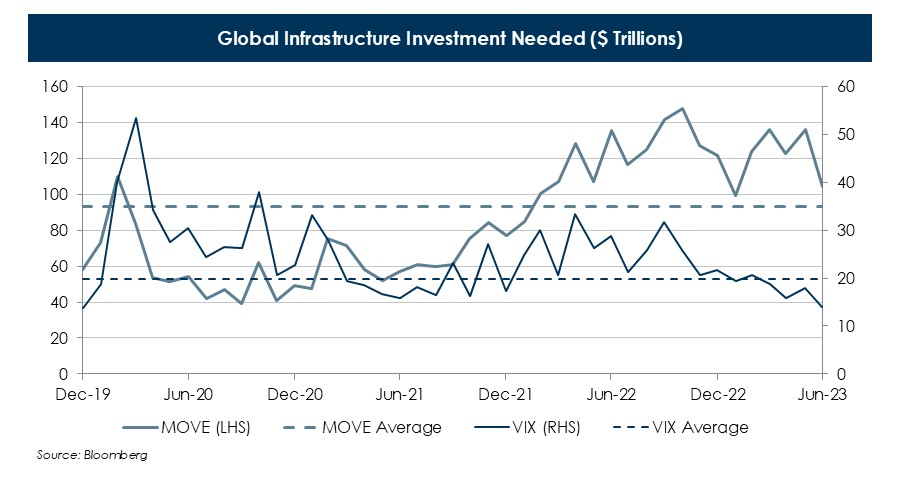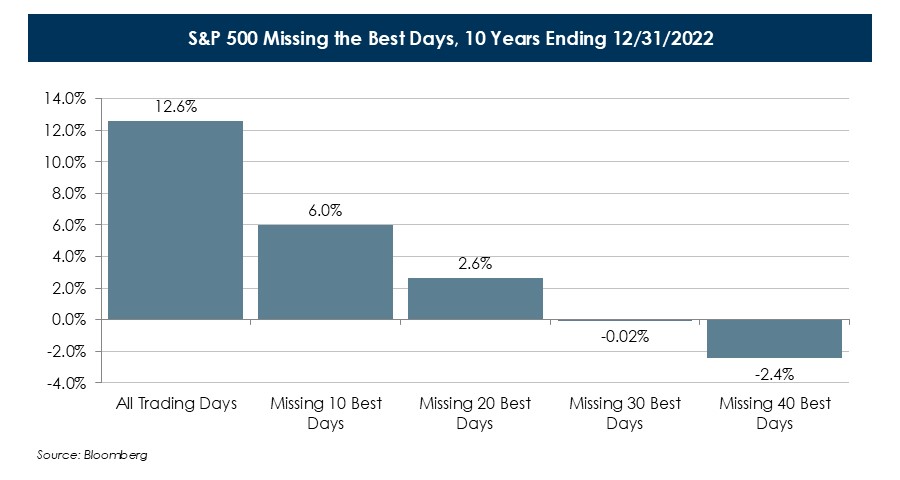Industry Insights
Market Volatility - No News is Good News
July 2023
- 24-hour news cycles, the advent of the internet, and online trading have increased the ability of investors to react quickly
- Volatility is ever-present in markets, but the long-term investor is often rewarded for looking past the headlines of the day
- For the long-term investor, short-term volatility offers opportunities to enhance portfolio outcomes
No Shortage of Recent Headlines
Post Global Financial Crisis, capital markets experienced a prolonged period of historically low interest rates, low inflation, and muted volatility. Over the past two years we have written about numerous events that have been the source of near constant headlines and increased market volatility: COVID, Russia’s war with Ukraine, a global spike in inflation, deglobalization, mid-term elections, elevated US debt levels, an inverted Treasury yield curve, China reopening, and the instability of the US banking system.
Despite these many events, most of which are ongoing, implied market volatility has reverted towards long-term historical norms, as measured by the VIX index (equities) and MOVE index (bonds).
.JPG)
Despite these many events, most of which are ongoing, implied market volatility has reverted towards long-term historical norms, as measured by the VIX index (equities) and MOVE index (bonds).
Volatility as an Opportunity
After a decade of relative underperformance, developed non-US markets have done well to start 2023, but mega-cap technology stocks have rallied around “AI” to lead global equity markets higher following a difficult 2022. Fixed income assets are also generally recovering from 2022 declines. Year-to-date through June 26th, a 60/40 mix of MSCI ACWI (+11.7%) and the Bloomberg US Agg (+2.5%) has returned 8.1%.
It is easy to immediately react to the news cycle of the day. However, investors are often rewarded by avoiding reactionary decisions and adhering to strategic asset allocations. Volatility is an ever-present and necessary function of capital markets and diversification. For the long-term investor, ignoring the negative headlines of the day can lead to enhanced outcomes.
For equity investors, there is value in remaining invested over time despite increasingly loud headline noise. Missing the ten best S&P 500 trading days in the decade ending in 2022 cuts the annualized return of the index by more than half. Historically, many of the best trading days occur within the same periods as the worst days. Over the last ten years (~2,500 trading days), the three best and five worst days for the S&P 500 all occurred within a 28-day period from March 9 to April 6, 2020. On March 16, when the index was down 12% on the day, few might have guessed from their quarantine location that the S&P 500 would be up 9.4% on March 24, just eight days later, enroute to an 18% total return for 2020.
Within US equity, diversification through a style-neutral approach to portfolio construction has been beneficial in reducing volatility in recent years. For example, in 2021 US Large Cap Growth “LCG” beat US Large Cap Value “LCV” by 2%, then in 2022 LCG lost to LCV by 22%, and 2023 YTD LCG is beating LCV by 22%.
Traditional fixed income managers are often afforded flexibility to allocate across an assortment of debt instruments (US Treasuries, corporate bonds, mortgage-backed securities, etc.). With this variety, usually there is at least one asset that offers some level of protection to the investor. In 2022, the Bloomberg US Aggregate bond index incurred the worst loss in its history of -13%. While no meaningful subsector of the index was positive last year, tactical portfolio rotations by Unconstrained managers such as avoiding long duration US Treasury bonds (-29.3%) in favor of 1-3-year maturity corporate bonds (-3.3%) benefitted relative performance and helped moderate losses.
.JPG)
Regardless of asset class, volatility creates opportunity for the various allocations within a diversified portfolio to work in tandem over the course of a market cycle.
It is easy to immediately react to the news cycle of the day. However, investors are often rewarded by avoiding reactionary decisions and adhering to strategic asset allocations. Volatility is an ever-present and necessary function of capital markets and diversification. For the long-term investor, ignoring the negative headlines of the day can lead to enhanced outcomes.
For equity investors, there is value in remaining invested over time despite increasingly loud headline noise. Missing the ten best S&P 500 trading days in the decade ending in 2022 cuts the annualized return of the index by more than half. Historically, many of the best trading days occur within the same periods as the worst days. Over the last ten years (~2,500 trading days), the three best and five worst days for the S&P 500 all occurred within a 28-day period from March 9 to April 6, 2020. On March 16, when the index was down 12% on the day, few might have guessed from their quarantine location that the S&P 500 would be up 9.4% on March 24, just eight days later, enroute to an 18% total return for 2020.
Within US equity, diversification through a style-neutral approach to portfolio construction has been beneficial in reducing volatility in recent years. For example, in 2021 US Large Cap Growth “LCG” beat US Large Cap Value “LCV” by 2%, then in 2022 LCG lost to LCV by 22%, and 2023 YTD LCG is beating LCV by 22%.
Traditional fixed income managers are often afforded flexibility to allocate across an assortment of debt instruments (US Treasuries, corporate bonds, mortgage-backed securities, etc.). With this variety, usually there is at least one asset that offers some level of protection to the investor. In 2022, the Bloomberg US Aggregate bond index incurred the worst loss in its history of -13%. While no meaningful subsector of the index was positive last year, tactical portfolio rotations by Unconstrained managers such as avoiding long duration US Treasury bonds (-29.3%) in favor of 1-3-year maturity corporate bonds (-3.3%) benefitted relative performance and helped moderate losses.
Regardless of asset class, volatility creates opportunity for the various allocations within a diversified portfolio to work in tandem over the course of a market cycle.
ACG’s Position
In today’s market environment, having a long-term view, remaining diversified, and avoiding quick reactions to the news of the day reinforces the benefits of and continued commitment to a long-term strategic allocation. We continue to believe in the benefits of a globally diversified equity portfolio. Diversified portfolios across regions, sectors, industries, market capitalizations, and styles are better suited to navigate spikes in short-run volatility and enhance long-term results. Similarly, we continue to believe fixed income portfolios can benefit long-term from incorporating complementary flexible mandates allowing managers to take advantage of short-term dislocations across the full opportunity set of the asset class.
